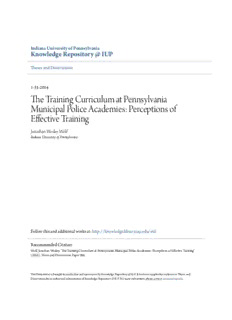
The Training Curriculum at Pennsylvania Municipal Police Academies PDF
Preview The Training Curriculum at Pennsylvania Municipal Police Academies
Indiana University of Pennsylvania Knowledge Repository @ IUP Theses and Dissertations (All) 1-31-2014 The Training Curriculum at Pennsylvania Municipal Police Academies: Perceptions of Effective Training Jonathan Wesley Wolf Indiana University of Pennsylvania Follow this and additional works at:http://knowledge.library.iup.edu/etd Recommended Citation Wolf, Jonathan Wesley, "The Training Curriculum at Pennsylvania Municipal Police Academies: Perceptions of Effective Training" (2014).Theses and Dissertations (All). 968. http://knowledge.library.iup.edu/etd/968 This Dissertation is brought to you for free and open access by Knowledge Repository @ IUP. It has been accepted for inclusion in Theses and Dissertations (All) by an authorized administrator of Knowledge Repository @ IUP. For more information, please [email protected], [email protected]. THE TRAINING CURRICULUM AT PENNSYLVANIA MUNICIPAL POLICE ACADEMIES: PERCEPTIONS OF EFFECTIVE TRAINING A Dissertation Submitted to the School of Graduate Studies and Research in Partial Fulfillment of the Requirements for the Degree Doctor of Education Jonathan Wesley Wolf Indiana University of Pennsylvania December 2013 Indiana University of Pennsylvania School of Graduate Studies and Research Department of Professional Studies in Education We hereby approve the dissertation of Jonathan Wesley Wolf Candidate for the degree of Doctor of Education ______________________ ____________________________________________ Cathy C. Kaufman, Ph.D. Professor of Education, Advisor ______________________ ____________________________________________ Jennifer V. Rotigel, Ed.D. Professor of Education ______________________ _____________________________________________ George R. Bieger, Ph.D. Professor of Education ACCEPTED __________________________________ ___________________________ Timothy P. Mack, Ph.D. Dean School of Graduate Studies and Research ii Title: The Training Curriculum at Pennsylvania Municipal Police Academies: Perceptions of Effective Training Author: Jonathan W. Wolf Dissertation Chair: Dr. Cathy C. Kaufman Dissertation Committee Members: Dr. Jennifer V. Rotigel Dr. George R. Bieger This study examined the perception of effective police academy training curriculum topics as reported by Pennsylvania municipal police officers. A second purpose explored the relationship between the police academy pedagogy and the perception of training adequacy that exists by individual officers. Using survey data from 152 municipal police officers this research found respondents have received the most adequate training in terms of knowledge, skills, and dispositions in the area of criminal law. The curricular topic of informants was perceived to be the least effective training area. Literature identified training gaps uncovered in Chapter II of this study showed officer training deficiencies in the areas of homeland security, cybercrime, and same-sex domestic violence. Homeland security ranked fourth in least adequacy. Cyber crime was the third least adequate training curriculum topic according to respondents. Same-sex domestic violence training was perceived to be the second least adequate. This study also sought to determine if there was a significant difference in the perceived adequacy of training between police officers who completed academy training at a higher educational academy and those who attended a governmental academy. An independent sample t-test showed no statistical significant difference. The results of this study also explored if a statistically significant difference exists in the level of militarism experienced between higher educational academies and governmental academies. This study found a significant degree of iii militarism does exist at academies conducted in a governmental setting compared to a higher educational facility. The results of this research add to the sparse literature that exists on varying police academy pedagogical techniques. The findings of this study provide valuable information for police academy instructors and curriculum authors. The information obtained as a result of this study can be used to better prepare police officers for their employment responsibilities. iv TABLE OF CONTENTS Chapter Page I INTRODUCTION…………………………………………………………. 1 Current Police Training Curricular Gaps………………………………….. 2 Brief History of Policing……………………………………………………6 Pedagogical Methods at Police Academies…………………………...…… 8 Problem Statement…………………………………………………………. 9 Purpose of the Study……………………………………………………….. 9 Significance of the Study……………………………………………...…… 10 Operational Definitions……………………………………………………..10 Theoretical Position………………………………………………...……… 12 Research Questions…………………………………………………...……. 16 Research Design…………………………………………………………….16 Limitations…………………………………………………………...…….. 16 Summary……………………………………………………………...……. 17 II REVIEW OF RELATED LITERATURE……………………...………….. 18 Introduction………………………………………………..………………. 18 Historical Perspectives of Policing…………………………..……………. 20 Greece………………………………………………..……………. 20 Italy……………………………………………………..…………. 21 England…………………………………………………...……….. 21 United States……………………………………………..……….. 24 Pennsylvania…………………………………………………..…... 29 Police Academy Training Research Literature……………………..……... 30 Police Academy Training Environments……………………………..….… 33 Field Training……………………………………………………………….38 Summary…………………………………………………………………… 39 III METHODOLOGY………………………………………………………… 40 Introduction………………………………………………………………... 40 Statement of the Problem………………………………………………….. 40 Research Questions………………………………………………………... 40 Survey Instrument Design……………………………………………......... 41 Reliability and Validity……………………………………………………. 42 Sample Size and Sampling Procedure……………………………………... 42 Data Collection…………………………………………………………….. 43 Survey Instrument…………………………………………………………. 44 Summary…………………………………………………………………... 46 v Chapter Page IV DATA ANALYSIS………………………………………………………... 47 Survey Respondent Demographics………………………………………... 48 Results……………………………………………………………………... 51 Data Analysis Question One………………………………………………. 65 Data Analysis Question Two………………………………………………. 68 Data Analysis Question Three…………………………………………….. 68 Summary…………………………………………………………………… 70 V SUMMARY, CONCLUSIONS, AND RECOMMENDATIONS……...…. 71 Summary………………………………………………………………...…. 71 Study Limitations………………………………………………………...… 71 Summary of Results……………………………………………………..… 72 Conclusion and Discussion…………………………………………..……. 73 Recommendations……………………………………………………..…… 76 Recommendations for Future Research………………………………..….. 77 Summary………………………………………………………………...…. 78 REFERENCES…………………………………………………………………………..… 80 APPENDICES……………………………………………………………………………... 88 vi LIST OF TABLES Table Page 1 Current Municipal Police Officers‟ Education and Training Commission Academy Curriculum Topics…………………………………30 2 Breakdown of Departments by Total Number of Officers Employed…………………………………………………………. 43 3 Municipal Police Officers‟ Education and Training Commission Academy Curriculum Sections and Certification Exam Topics…………… 45 4 Gender and Academy Location of Respondents……………………………49 5 Employment Longevity of Respondents……………………………………50 6 Education Level of Respondents…………………………………………... 51 7 Introduction to Law Enforcement…………………………………………. 52 8 Laws and Procedures………………………………………………………. 52 9 Defensive Tactics………………………………………………………….. 54 10 Motor Vehicle Law Enforcement………………………………………….. 54 11 Patrol Procedures and Operations…………………………………………. 55 12 Principles of Criminal Investigation………………………………………. 57 13 Human Relations………………………………………………………....... 59 14 Crises Management and Intervention……………………………………… 60 15 Families in Crises………………………………………………………….. 60 16 Report Writing……………………………………………………………... 61 17 Case Preparation…………………………………………………………… 62 18 Handling Arrested Persons………………………………………………… 62 vii Table Page 19 Research Identified Training Gaps………………………………………… 64 20 Ranking of the Academy Curriculum Topics……………………………… 65 21 Program Type Differences in Perceived Adequacy of the Training Program……………………………………………………………………. 68 22 Program Type Differences in Perceived Militarism of the Training Program…………………………………………………………... 69 viii LIST OF FIGURES Figure Page 1 Degree of Militarism………………………………………………………. 69 ix
Description: